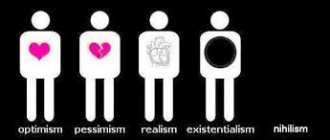- What is the theory of subpersonalities?
- Subpersonalities in psychology
- How are human subpersonalities formed?
- Working with human subpersonalities
A person is a multifaceted personality, a being in which different parts live. In psychology, they are called subpersonalities, representing specific psychological formations that live in our space. A person's subpersonalities include his behavior patterns, beliefs and feelings. In other words, these are programs created by a person’s subconscious to perform specific tasks or to fulfill certain roles. Each of us has witnessed at least once in our lives a conversation that took place in our own minds. It’s as if completely different people are arguing with each other at the same time, each of whom has their own character. A certain internal conflict arises and the person seems to begin to be thrown from one side to the other. He first makes some decisions, then cancels them and makes completely different ones.
Definition of the concept of subpersonality in psychology
The concept of human subpersonality was introduced by the Italian psychologist and psychiatrist R. Assagioli. In psychology, it is customary to use the following definition of subpersonality, it was given by Asagioli: “This is a certain set of attitudes, behavioral stereotypes, beliefs, drives, etc., which takes on a holistic, discernible form only in our consciousness.”
Have you noticed that you sometimes react differently to the same events? Why do you behave differently in similar conditions? This is how other selves manifest themselves. They find expression in our actions, words, actions, thoughts, qualities, abilities, skills. They are associated with social roles and statuses. Each person plays many roles. Sometimes they come into conflict; at such moments we turn to ourselves, talk to ourselves, or rather, to alternative personalities.
Interesting! The term “subpersonality” in psychology is a psychological metaphor that psychologists use to simplify and shorten the description of a certain set of habits, beliefs, and personality traits. In addition to internal changes, when changing subpersonalities, external changes are also noticeable. A person's posture, tone of voice, speed of speech, facial expressions and gestures may change.
Subpersonalities are not a pathology, but a norm. The inner world of a person consists of many selves. They help satisfy needs and desires, protect the main self. A completely logical question arises: if this is normal and even good, then why does psychology pay so much attention to this phenomenon, why is it so important to work on subpersonalities? Let's understand everything in order.
Menu
Start
The path of self-discovery
|
Esoteric events
Article settings
| Add an article | |
| Add information about your center | |
| @ |
Why work with them?
Alternative personalities can live peacefully, or they can harm each other and enter into conflicts. We need to work on this so that a person controls his subpersonalities, and not they control him. It is also important to ensure that all alternative selves coexist in harmony. If some kind of “I” harms a person and his environment, then this subpersonality needs to be gotten rid of.
Remember! Working with subpersonalities is necessary so that they do not get out of control.
Why are human subpersonalities dangerous?
I think, having reached this point in the article, you have already asked the question: “Where is the fine line between the norm and pathologies in the form of dissociative identity disorder (split personality disorder)?” Yes, this is why alternative selves are dangerous: they can absorb a person’s true self. Moreover, mental disorder is an extreme variant of complications.
There is another danger: a person does not lose touch with reality, but there are so many alternative personalities that they lead the individual further and further from himself, lead him astray from the true path, and prevent him from finding his purpose. Simply put, a person lives according to someone else’s scenario and cannot fully realize himself.
Therefore, it is so important to bring this to the level of awareness and control the process, be able to switch from one personality to another, understand why you need each of them, when they come in handy, etc.
Remember! There are useful and negative subpersonalities. The former help a person in development, the latter hinder the development of personality.
What does this give?
There is good news for the training participants: any subpersonality, any quality in yourself can be developed. And moreover, create a harmonious ensemble from subpersonalities, a combination of qualities that will excite the minds, delight, excite, inspire and inspire the men who find themselves next to you. And not only your husbands and lovers, but also those men who are your friends, business partners, your managers and subordinates.
To diagnose and correct the situation, we will use the method of structural arrangements. In the arrangement we will look at how subpersonalities interact with each other. It may turn out that some of them look weak and undeveloped. Others, on the contrary, occupy all the space. You can immediately find out the reasons for this condition. For example, in a woman’s parental family, it was not customary to show sexuality, and talking about sex was condemned. And therefore, in today’s situation, a woman has locked up not only the sexual energies necessary to communicate with a man, but also the creative energies necessary for her career and development. After identifying the causes of the problem, negative attitudes and beliefs can be returned to where they came from, put things in order, and put everything in its place. And free yourself for a new creative and successful life.
Of course, we will not be able to make arrangements for all participants. You must register for your arrangement in advance. But everyone else will have no less fun: they will be able to ask questions, participate in discussions, and see how limiting beliefs are formed.
How do human subpersonalities arise?
All alternative selves are puzzled by the same thing - protecting the inner child. Actually, this is how they arise. They protect the child from the negative influence of the external environment, help to develop and achieve goals.
Psychologist S. Schwartz described step by step the mechanism of the emergence of alternative selves:
- A person receives psychological trauma, subpersonalities arise to protect him from negative feelings and emotions: fear, shame, guilt, pain. They are called exiles.
- A manager appears to control the exile. He tries with all his might to protect a person from negativity. For example, if pain and disappointment in the mother have been expelled, then the manager can protect the person with the help of emotional coldness, detachment from people, and distrust.
- Sometimes managers fail to cope, a person again finds himself in an unpleasant situation, then firefighters - another group of subpersonalities - resort to extinguishing all these feelings. They choose the most aggressive methods and do everything to numb the pain. This is how alcohol, promiscuity, extreme sports, rage, rudeness, etc. burst into a person’s life.
Not only does the person himself unconsciously create other selves, this process can be made conscious. A psychologist can create subpersonalities to help a client cope with a current problem. A person himself can create subpersonalities that improve the quality of his life.
Important! The development of other selves depends on the personality characteristics and imagination of a person. The number and specificity of alternative selves differs from case to case; each individual has his own set of subpersonalities.
Temperament
Temperament is those properties of the psyche that are responsible for its processes and human states.
The following main types of temperament, defined by Hippocrates, are distinguished:
- melancholic,
- choleric,
- phlegmatic,
- sanguine.
A melancholic person is characterized by a tense inner life. People with this temperament are usually gloomy, vulnerable, and have a high level of anxiety. They are restrained in communication, get tired quickly, and give in to difficulties.
Cholerics are quick-tempered, impulsive people, persistent. They have difficulty restraining their emotions, but quickly calm down if they get their way. Such people are true to their interests and aspirations.
Phlegmatic people are efficient and patient, they know how to control themselves perfectly. These are cold-blooded people who are difficult to disturb, but if this happens, it is difficult for them to calm down. Those with a phlegmatic temperament have difficulty adapting to new things and do not easily get rid of old habits.
Sanguine people are cheerful, optimistic, sociable people who love to joke. They are open to new things and easily adapt to changes, they are disciplined in their work and are able to keep their emotions in check.
This is a general and incomplete classification that gives general ideas about temperament.
You need to understand that a person can combine traits of different temperaments and that these types are not often found in their pure form.
Character
In psychology, character is understood as the way a person interacts with other people and the world. It is formed depending on the social conditions in which the individual is located and raised.
Character is manifested in the reaction to the actions of other people, in the manners of the person himself. Many character traits can be grouped into three groups:
- strong-willed,
- business,
- communicative,
- motivational,
- instrumental.
As it is not difficult to guess, strong-willed character traits determine a person’s will and its accompanying qualities (perseverance, determination, compliance).
Business traits are how an individual behaves during work (conscientiousness, laziness, responsibility, tendency to procrastinate).
Communication traits determine how contactable and sociable a person is, how he communicates with others (openness, kindness, politeness, rudeness, isolation).
Motivational traits mean those qualities that encourage action, directing it. Instrumental traits give a certain style to human behavior.
Emotions
Emotions in psychology are defined as individual experiences that arise when vital needs are satisfied (dissatisfied). They may be pleasant or not.
A person is capable of experiencing a variety of emotions, but the main ones include the following:
- the simplest emotions
- mood,
- affects,
- feelings.
The simplest emotions, their manifestation, are associated with the satisfaction of physiological needs.
Mood is a set of emotions that can describe the state of an individual at a certain moment.
Affects can be called strong short-term emotions that have...
By feelings, psychologists understand an individual’s experiences caused by a certain object.
Emotionally, people are very different from each other. These differences consist of different intensity and direction, and the duration of the experience of emotions.
Emotions influence decision-making and specific actions. This is why it is important to control your feelings.
Motivation
Motivation is a set of reasons that can explain an individual’s behavior. It depends on the following factors:
- motives,
- incentives,
- needs, needs
- motives,
- intentions.
Motive determines the purposefulness of behavior. It is based on either a psychological or physiological impulse.
The stimulus can be an internal or external factor. Under its influence, an individual strives to achieve a certain goal and solve a problem. Motive and incentive jointly control human behavior.
Need can be understood as a state in which something is missing for the normal functioning of both mental and physical.
In psychology, motivation is understood as an individual’s not fully conscious, perhaps not fully defined, desire for something.
Intention is a conscious, thoughtful decision based on the desire to perform a certain action.
Motivation is what makes a person not stand still in his development. It is important to understand that for each person the “driving force” will be different. And what motivates one may not “inspire” another at all.
Personality is a complex and multifaceted concept. But basic knowledge about it will help you better understand yourself and those around you and build more harmonious relationships.
Types of subpersonalities
In psychology, it is customary to distinguish conscious (clear) and unconscious (shadow) subpersonalities:
- Explicit. These are the roles, qualities, statuses, programs with which a person identifies himself: “I am a father,” “I am a very patient person,” etc.
- Shadow. These are those scenarios that a person is not aware of, but they constantly guide him through life: “I don’t know what came over me,” “Sometimes I break down for no reason,” “Sometimes I feel so bad that I can’t get out of bed.” . I don’t know why this happens.”
The union of obvious and shadow subpersonalities is usually called a conciliar personality. As a rule, a person associates this image with his name.
In addition, we can distinguish main (among them one dominant) and auxiliary subpersonalities. Those that are basic are obvious and are included more often than others. Auxiliary ones manifest themselves from time to time, more often they are of an unconscious nature. And even less often, random subpersonalities arise. They can become fixed and turn into main or auxiliary ones.
Personality structure
To better understand the term, it is worth considering its structure.
The structure of personality can be understood as the interaction of its component parts (character, aspirations, will, abilities, emotions). These parts (components) characterize a person; they can be called her traits. To structure these personality-defining traits, the following levels are distinguished:
- lower,
- second,
- third,
- higher.
The lowest level is the mental characteristics of a person determined by gender, age, and innate qualities.
The second level involves individual characteristics depending on innate qualities and their development (memory, thinking, abilities, perception of the surrounding world).
The third level is formed throughout life and is associated with socialization. It defines individual experience (knowledge acquired throughout life, habits, skills).
The highest level reflects the worldview, inclinations, beliefs, character traits, the so-called personality orientation. The highest level is most dependent on the social environment in which the formation of personality occurs. Education has a strong influence on the formation of this level. This structure gives a generalized idea of personality. Each person is multifaceted and the differences between people at each level of the structure discussed above are determined by individual experience, beliefs, character, and knowledge. This versatility and individuality often becomes the reason why it is difficult to understand an opponent and avoid conflict situations.
To better understand others and yourself, you need to have an idea of personality characteristics, be aware and observant.
How subpersonalities manifest themselves in life
In life, you can most often find the following list of human subpersonalities (according to the specifics of behavior and leading qualities):
- wolf – manifested by anger and aggression;
- fox - expressed in cunning, guile, flattery, etc.;
- hare - manifests itself as cowardice, numerous fears in all areas of life (and sometimes a person understands that it is high time to change something, but does not dare to do so);
- piglet - noticeable through greed in all areas of life, sometimes taking pathological forms, for example, turning into a craving for hoarding;
- ram - expressed in stupidity, inability to listen to others and perceive rational arguments, stubbornness;
- alcoholic – expressed in drunkenness and riotous lifestyle;
- glutton – manifested by systematic overeating, inability to control one’s actions, and a constant feeling of hunger;
- smoker - manifests itself in an obsessive need to smoke, coming up with reasons not to quit (“The work is stressful”, “This makes me want to eat less”, “If I quit, I’ll get fat”).
In psychology, there is no single classification of subpersonalities by name; there are thousands of them. For example, in addition to those that we have already named, there are the following:
- egoist,
- endured
- small man,
- dreamer,
- good man,
- impudent,
- holy man,
- Jonah,
- hypocrite,
- many, many others.
A person himself gives names to his subpersonalities, sometimes his environment helps him in this.
Important! Every person has at least three subpersonalities: adult, child, parent.
Exercises to work with subpersonalities
In psychology, there are many techniques that are suitable for independent use, helping to understand the inner selves and learn to interact with them. Let's look at some exercises for working with subpersonalities.
Talking to your inner critic
All people have this subpersonality. For some it is more pronounced, for others it is weaker, but we all periodically criticize and scold ourselves. It's good if it doesn't turn into self-flagellation. If a critic is exhausting you, then it’s time to meet and talk with him.
Draw your critic as a person. To make it easier, answer the following questions:
- What is he like?
- How and when does it manifest itself?
- How does it affect you, your decisions and actions?
- How does he react to your counterarguments and rational comments?
- What does he criticize more often: you or the world around you?
Get to know him, and then learn to communicate. The next time he starts saying that nothing will work out, ask: “What will happen if...?” If a critic forces you to do something or dissuades you from something, then ask him: “Can you cope with the consequences?” Tell him what you would like to hear in difficult times. Which of his comments will help you and not drown you in the abyss of self-flagellation.
And most importantly, think about how appropriate his criticism is, in whose voice he speaks. Very often the critic speaks in the voice of the parents, and upon analysis it turns out that most of the comments are irrational. The better you understand your critic, the better you can control him.
Circle of subpersonalities
This technique allows you to diagnose positive subpersonalities.
Technique:
- Write down all your intangible desires. Write whatever comes to mind. You need to score at least 20 positions.
- Re-read the list and concentrate on how you feel about each item. Maybe at one of them you heard a menacing and condemning voice: “What will people think?” Or the inspired: “How can you not want this, everyone wants it.”
- Choose 5-6 desires that are more relevant to you than the rest.
- On a piece of paper, draw a circle with a diameter of 20 cm, with another circle inside. The center is the real you. Place the selected 5-6 wishes in a small circle. Distribute the rest beyond the first circle and up to the second.
- Each of your desires is a subpersonality. Draw them with colored pencils (one image for each wish), give them names. Each name should be clear and meaningful to you, make sense.
- Think about where else, besides desires, these subpersonalities express themselves, when and how this happens.
Now you are familiar with your main positive subpersonalities. Monitor when they express themselves, promote their development.
Personal diary
Many people think that keeping a personal diary is for 12-year-old girls. But in fact, this is an excellent psychotherapeutic method available to everyone. Diaries can be different, for example, you can keep a diary of emotions and actions. Write down vivid events, especially those when you say, “I don’t understand why everything is like this.”
Analyze records. Very soon you will understand that much of your behavior, your states and reactions are not accidental, but natural. You will be able to identify several patterns of behavior. Yes, they may be directly opposite to each other, but all of this is you, or rather, these are your subpersonalities. The next step is to identify destructive models (subpersonalities) and work on them.
Main characteristics
In psychology, personality characteristics are understood as those mental phenomena through which an individual manifests himself in communication with others and in everyday activities. The following main personality characteristics are distinguished:
- capabilities,
- will,
- temperament,
- character,
- emotions,
- motivation.
Capabilities
When it comes to a person’s successes and achievements (for example, studying at school), abilities are considered to be the criterion for assessing this success.
Abilities can be called properties of the soul, uniting all mental processes and states of a person. They also mean the totality of all the skills of an individual, thanks to which he successfully performs certain actions. Simply put, ability is both the ability to do something well, for example, to draw, and to experience strong feelings, for example, love or compassion.
Abilities are divided into:
- complex and simple
- practical and theoretical,
- educational and creative,
- general and special,
- communicative and subject-active.
Complex and simple abilities
The simplest include innate abilities based on the activity of the senses and elementary motor activity. For example, the ability to distinguish colors, sounds, walk, sit, and so on.
Complex abilities are understood as skills related to human culture (painting pictures, the ability to solve difficult problems in physics, etc.). These are not innate abilities; they are socially conditioned.











